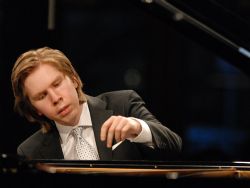|
Symphony
FROM THE NEW WORLD TO THE OLD WORLD
by Peter Lert
Saturday, June 14, 2025
Chamber
MC2 DUO RECITAL CLOSES 222'S SEASON
by Terry McNeill
Saturday, June 14, 2025
Choral and Vocal
CANTIAMO SONOMA'S LUSCIOUS A CAPELLA SINGING IN SEASON ENDING CONCERT
by Pamela Hicks Gailey
Sunday, June 8, 2025
Symphony
SRS SEASON ENDS WITH RESOUNDING TA-TA-TA-BANG
by Terry McNeill
Sunday, June 1, 2025
Symphony
YOUTHFUL VIRTUOSITY ON DISPLAY AT USO'S MAY CONCERTS
by Peter Lert
Saturday, May 17, 2025
Symphony
MYSTICAL PLANETS AND LIVELY GERSHWIN ORTIZ AT FINAL SRS CONCERT
by Peter Lert
Sunday, May 4, 2025
Symphony
VSO'S CONCERT MUSIC OF TIME, MUSIC OF PLACE
by Peter Lert
Sunday, April 27, 2025
VOCAL ELEGANCE AND FIRE AT THE 222'S RECITAL APRIL 26
by Pamela Hicks Gailey
Saturday, April 26, 2025
CANTIAMO SONOMA SINGS AN INSPIRED GOOD FRIDAY MOZART REQUIEM CONCERT
by Pamela Hicks Gailey
Friday, April 18, 2025
DRAMATIC SHOSTAKOVICH SYMPHONY CLOSES PHILHARMONIC'S 25TH SEASON
by Terry McNeill
Sunday, April 13, 2025
|
 |
 Pianist Juho Pohjonen |
THE BALLADE OF JUHO POHJONEN
by Terry McNeill
Sunday, September 14, 2014
Planning a piano program around a single theme or name can be tricky because cutesy connections can easily displace artistic merit. Fortunately, Juho Pohjonen's Sept. 14 recital in the inaugural "Sundays at Schroeder" concert was a textbook example of a successful theme--ballades--supported by wonderful music.
Grieg's seldom-played G Minor ballade had perhaps the most convincing performance of the afternoon. Built on 14 variations on a Norwegian folk song, the work is the composer's best extended-form piano piece. Mr. Pohjonen played it in a unhurried way with careful control of dynamics and just a hint of sadness. Pedaling was precise, and even the three most extroverted variations were clearly phrased and articulated.
Brahms' four early Op. 10 ballades completed the first half. Here again the Finnish pianist played with stable chordal weighting and fastidious thematic voicing. The gentle D Major Andante featured good staccato playing in the middle section. The Intermezzo moved from darkness to a cantabile of radiant light in the concluding Romanza. The slow playing had sentiment without a hint of sentimentality. Everything in the four components of the ballade's ersatz sonata structure was always in place.
In contrast to the efforts of Brahms and Grieg, each of the four Chopin ballades tells a story. Here Mr. Pohjonen stumbled. He is an exemplar of his musical generation in that rubatos are tight, inner voices are absent, repeats are played the same way each time, and the vocal nature of Chopin's exquisite melodies is slighted. The pianist's technique, however, is well suited to the unfolding agitation of the ballades. The F Major and the A-Flat Major received the most convincing playing benefiting from small pedal effects, fast right-hand scales and engaging rhythms.
Less compelling were the bookend ballades, arguably among the pinnacles of Chopin's genius. In both the G Minor and F Minor, pianistic frenzy often displaced thematic ardor and grandeur. The intricate and tumultuous coda of the F Minor became jumbled in the artist's rush to secure a potent finish.
Responding to a standing ovation from the audience of 160, Mr. Pohjonen played a limpid Grieg lyric piece, Op. 43, No. 6, "To the Spring." His captivating performance ended with two beguiling arpeggiated chords and a crossover left-hand pianissimo F.
|
